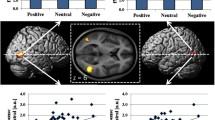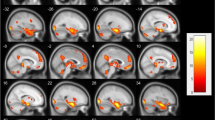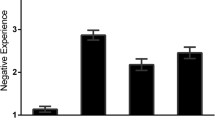Abstract
Neuroticism is a personality trait that reflects emotional instability and is related to negative emotions, such as sensitivity to negative information and negative appraisal. Existing studies on the neural basis of the neuroticism personality trait have focused on explicit emotion processing and neglected to acknowledge the potentially important role of implicit emotion processing, especially using an fMRI (functional magnetic resonance imaging) task with a Chinese sample. Therefore, in the present study, we aimed to investigate differences in brain activation in an implicit negative emotion processing fMRI task between individuals with high and low neuroticism scores within a Chinese sample. To this end, the revised NEO-PI-R (Neuroticism-Extraversion-Openness Personality Inventory) was used to identify 82 high-neuroticism participants and 82 low-neuroticism participants, who were then scanned during an implicit negative emotion processing fMRI task. Compared to the participants with low neuroticism scores, those with high neuroticism scores showed significantly decreased brain activation in the mPFC (medial prefrontal cortex), which plays a pivotal role in implicit emotion processing; these data might suggest that individuals with high neuroticism have deficits in implicit negative emotion processing, which may be related to their emotional instability, emotional regulation and attention-related spontaneous activity.



Similar content being viewed by others
Data Availability
The datasets generated and analysed during the current study are available from the corresponding author on reasonable request.
References
Association, W. M. (1991). Declaration of Helsinki. Law, medicine & health care: A publication of the American Society of law & medicine. Gastroenterologia Japonica, 26(2), 269–270.
Balada, F., Lucas, I., Blanch, A., Blanco, E., & Aluja, A. (2019). Neuroticism is associated with reduced oxygenation levels in the lateral prefrontal cortex following exposure to unpleasant images. Physiology & Behavior, 199, 66–72. https://doi.org/10.1016/j.physbeh.2018.11.002.
Banks, S. J., Eddy, K. T., Angstadt, M., Nathan, P. J., & Phan, K. L. (2007). Amygdala - frontal connectivity during emotion regulation. Social Cognitive and Affective Neuroscience, 2(4), 303–312. https://doi.org/10.1093/scan/nsm029.
Becker, B., Wagner, D., Koester, P., Tittgemeyer, M., Mercerchalmersbender, K., Hurlemann, R., ... Daumann, J. (2015). Smaller amygdala and medial prefrontal cortex predict escalating stimulant use. Brain: A Journal of Neurology, 138(7), 2074–2086.
Bocharov, A. V. (2009). Event-related delta and theta synchronization during explicit and implicit emotion processing. Neuroscience, 164(4), 1588–1600.
Buchanan, T. W., Driscoll, D., Mowrer, S. M., Rd, S. J., Thayer, J. F., Kirschbaum, C., & Tranel, D. (2010). Medial prefrontal cortex damage affects physiological and psychological stress responses differently in men and women. Psychoneuroendocrinology, 35(1), 56–66.
Calboli, F. C. F., Tozzi, F., Galwey, N. W., Antoniades, A., Mooser, V., Preisig, M., ... Johnson, M. R. (2010). A genome-wide association study of neuroticism in a population-based sample. PLoS One, 5(7), e11504.
Canli, T. (2010). Functional brain mapping of extraversion and neuroticism: Learning from individual differences in emotion processing. Journal of Personality, 72(6), 1105–1132.
Canli, T., Zhao, Z., Desmond, J. E., Kang, E., Gross, J., & Gabrieli, J. D. E. (2001). An fMRI study of personality influences on brain reactivity to emotional stimuli. Behavioral Neuroscience, 115(1), 33–42.
Costa, P. T., & Mccrae, R. R. (1992). Neo PI-R professional manual 7(4), 329–345.
Cremers, H. R., Demenescu, L. R., Aleman, A., Renken, R., van Tol, M. J., Nj, V. D. W., ... Roelofs, K. (2010). Neuroticism modulates amygdala-prefrontal connectivity in response to negative emotional facial expressions. Neuroimage, 49(1), 963–970.
Denney, D. R., & Frisch, M. B. (1981). The role of neuroticism in relation to life stress and illness. Journal of Psychosomatic Research, 25(4), 303–307.
Drabant, E. M., Mcrae, K., Manuck, S. B., Hariri, A. R., & Gross, J. J. (2009). Individual differences in typical reappraisal use predict amygdala and prefrontal responses. Biological Psychiatry, 65(5), 367–373.
Etkin, A., Büchel, C., & Gross, J. J. (2015). The neural bases of emotion regulation. Nature Reviews Neuroscience, 16(11), 693–700.
Etkin, A., Prater, K. E., Hoeft, F., Menon, V., & Schatzberg, A. F. (2010). Failure of anterior cingulate activation and connectivity with the amygdala during implicit regulation of emotional processing in generalized anxiety disorder. American Journal of Psychiatry, 167(5), 545–554.
Friesen, W. V. (1986). A new pan-cultural facial expression of emotion. Motivation and Emotion, 10(2), 159–168.
Goldin, P. R., Mcrae, K., Ramel, W., & Gross, J. J. (2008). The neural bases of emotion regulation: Reappraisal and suppression of negative emotion. Biological Psychiatry, 63(6), 577–586.
Gyurak, A., Gross, J. J., & Etkin, A. (2011). Explicit and implicit emotion regulation: A dual-process framework. Cognition & Emotion, 25(3), 400–412. https://doi.org/10.1080/02699931.2010.544160.
Haas, B. W., Constable, R. T., & Canli, T. (2008). Stop the sadness: Neuroticism is associated with sustained medial prefrontal cortex response to emotional facial expressions. Neuroimage, 42(1), 385–392.
Harenski, C. L., Kim, S. H., & Hamann, S. (2009). Neuroticism and psychopathy predict brain activation during moral and nonmoral emotion regulation. Cognitive, Affective, & Behavioral Neuroscience, 9(1), 1–15.
Hariri, A. R., Drabant, E. M., Munoz, K. E., Kolachana, B. S., Mattay, V. S., Egan, M. F., & Weinberger, D. R. (2005). A susceptibility gene for affective disorders and the response of the human amygdala. Archives of General Psychiatry, 62(2), 146.
Hariri, A. R., Tessitore, A., Mattay, V. S., Fera, F., & Weinberger, D. R. (2002). The amygdala response to emotional stimuli: A comparison of faces and scenes. Neuroimage, 17(1), 317–323.
Hoid, D., Pan, D.-N., Wang, Y., & Li, X. (2020). Implicit emotion regulation deficits in individuals with high schizotypal traits: An ERP study. Scientific Reports, 10(1), 3882. https://doi.org/10.1038/s41598-020-60787-9.
Hooker, C., Verosky, S. A., Knight, R., & D'Esposito, M. (2008). The influence of personality on neural mechanisms of observational fear and reward learning. Neuropsychologia, 46(11), 2709–2724.
Indovina, I., Conti, A., Lacquaniti, F., Staab, J. P., Passamonti, L., & Toschi, N. (2019). Lower functional connectivity in vestibular-limbic networks in individuals with subclinical agoraphobia. Frontiers in Neurology, 10, 874. https://doi.org/10.3389/fneur.2019.00874.
Jeronimus, B. F., Ormel, J., Aleman, A., Penninx, B. W. J. H., & Riese, H. (2015). Negative and positive life events are associated with small but lasting change in neuroticism. Psychological Medicine, 43(11), 2403–2415.
Jimura, K., Konishi, S., & Miyashita, Y. (2009). Temporal pole activity during perception of sad faces, but not happy faces, correlates with neuroticism trait. Neuroscience Letters, 453(1), 45–48.
John, O. P., & Gross, J. J. (2004). Healthy and unhealthy emotion regulation: Personality processes, individual differences, and life span development. Journal of Personality, 72(6), 1301–1334.
Klamer, S., Schwarz, L., Krueger, O., Koch, K., Erb, M., Scheffler, K., & Ethofer, T. (2017). Association between neuroticism and emotional face processing. Scientific Reports, 7, 17669. https://doi.org/10.1038/s41598-017-17706-2.
Kootker, J. A., Mierlo, M. L. V., Hendriks, J. C., Sparidans, J., Rasquin, S. M., Kort, P. L. D., ... Geurts, A. C. (2016). Risk factors for symptoms of depression and anxiety one year Poststroke: A longitudinal study. Archives of Physical Medicine & Rehabilitation, 97(6), 919–928.
Lee, H., Heller, A. S., van Reekum, C. M., Nelson, B., & Davidson, R. J. (2012). Amygdala-prefrontal coupling underlies individual differences in emotion regulation. Neuroimage, 62(3), 1575–1581.
Leroy, A., Spotorno, S., & Faure, S. (2020). Emotional scene processing in children and adolescents with attention deficit/hyperactivity disorder: A systematic review. European Child & Adolescent Psychiatry. https://doi.org/10.1007/s00787-020-01480-0.
Liu, W., Wei, D., Chen, Q., Yang, W., Meng, J., Wu, G., Bi, T., Zhang, Q., Zuo, X. N., & Qiu, J. (2017). Longitudinal test-retest neuroimaging data from healthy young adults in Southwest China. Scientific Data, 4, 170017. https://doi.org/10.1038/sdata.2017.17.
Lucas, I., Balada, F., Blanco, E., & Aluja, A. (2019). Prefrontal cortex activity triggered by affective faces exposure and its relationship with neuroticism. Neuropsychologia, 132, 107146. https://doi.org/10.1016/j.neuropsychologia.2019.107146.
Maldjian, J. A., Laurienti, P. J., Kraft, R. A., & Burdette, J. H. (2003). An automated method for neuroanatomic and cytoarchitectonic atlas-based interrogation of fMRI data sets. Neuroimage, 19(3), 1233–1239.
Miller, E. K., & Cohen, J. D. (2001). An integrative theory of prefrontal cortex function. Annual Review of Neuroscience, 24(1), 167–202.
Morillas-Romero, A., Tortella-Feliu, M., Balle, M., & Bornas, X. (2015). Spontaneous emotion regulation and Attentional control. Emotion, 15(2), 162–175. https://doi.org/10.1037/emo0000016.
Ochsner, K. N., & Gross, J. J. (2005). The cognitive control of emotion. Trends in Cognitive Sciences, 9(5), 242–249.
Ochsner, K. N., Ray, R. D., Cooper, J. C., Robertson, E. R., Chopra, S., Gabrieli, J. D., & Gross, J. J. (2004). For better or for worse: Neural systems supporting the cognitive down- and up-regulation of negative emotion. Neuroimage, 23(2), 483–499.
Pereira-Morales, A. J., Adan, A., & Forero, D. A. (2019). Perceived stress as a mediator of the relationship between neuroticism and depression and anxiety symptoms. Current Psychology, 38, 66–74.
Rampino, A., Torretta, S., Rizzo, G., Viscanti, G., Quarto, T., Gelao, B., Fazio, L., Attrotto, M. T., Masellis, R., Pergola, G., Bertolino, A., & Blasi, G. (2019). Emotional stability interacts with cortisol levels before fMRI on brain processing of fearful faces. Neuroscience, 416, 190–197. https://doi.org/10.1016/j.neuroscience.2019.08.002.
Ready, R. E., & Santorelli, G. D. (2016). Emotion regulation and memory: Differential associations in younger and midlife/older adults. Experimental Aging Research, 42(3), 264–278. https://doi.org/10.1080/0361073x.2016.1156971.
Riccelli, R., Indovina, I., Staab, J. P., Nigro, S., Augimeri, A., Lacquaniti, F., & Passamonti, L. (2017). Neuroticism modulates brain visuo-vestibular and anxiety systems during a virtual rollercoaster task. Human Brain Mapping, 38(2), 715–726. https://doi.org/10.1002/hbm.23411.
Rubino, V., Blasi, G., Latorre, V., Fazio, L., d’Errico, I., Mazzola, V., ... Hariri, A. (2007). Activity in medial prefrontal cortex during cognitive evaluation of threatening stimuli as a function of personality style. Brain Research Bulletin, 74(4), 250–257.
Saeed, A. I. (2016). The role of neuroticism in the maintenance of chronic baseline stress perception and negative affect. Spanish Journal of Psychology, 19, E9.
Saggar, M., Vrticka, P., & Reiss, A. L. (2016). Understanding the influence of personality on dynamic social gesture processing: An fMRI study. Neuropsychologia, 80, 71–78. https://doi.org/10.1016/j.neuropsychologia.2015.10.039.
Servaas, M. N., van der Velde, J., Costafreda, S. G., Horton, P., Ormel, J., Riese, H., & Aleman, A. (2013). Neuroticism and the brain: A quantitative meta-analysis of neuroimaging studies investigating emotion processing. Neuroscience & Biobehavioral Reviews, 37(8), 1518–1529. https://doi.org/10.1016/j.neubiorev.2013.05.005.
Urry, H. L., van Reekum, C. M., Johnstone, T., Kalin, N. H., Thurow, M. E., Schaefer, H. S., ... Alexander, A. L. (2006). Amygdala and ventromedial prefrontal cortex are inversely coupled during regulation of negative affect and predict the diurnal pattern of cortisol secretion among older adults. Journal of Neuroscience: The Official Journal of the Society for Neuroscience, 26(16), 4415-4425.
Volokhov, R. N., & Demaree, H. A. (2010). Spontaneous emotion regulation to positive and negative stimuli. Brain and Cognition, 73(1), 1–6. https://doi.org/10.1016/j.bandc.2009.10.015.
Wager, T. D., Davidson, M. L., Hughes, B. L., Lindquist, M. A., & Ochsner, K. N. (2008). Prefrontal-subcortical pathways mediating successful emotion regulation. Neuron, 59(6), 1037–1050.
Wang, M.-Y., Zhang, J., Lu, F.-M., Xiang, Y.-T., & Yuan, Z. (2018). Neuroticism and conscientiousness respectively positively and negatively correlated with the network characteristic path length in dorsal lateral prefrontal cortex: A resting-state fNIRS study. Brain and Behavior: A Cognitive Neuroscience Perspective, 8(9), e01074. https://doi.org/10.1002/brb3.1074.
Wang, Y., Du, Y., Li, J., & Qiu, C. (2019). Lifespan intellectual factors, genetic susceptibility, and cognitive phenotypes in aging: Implications for interventions. Frontiers in Aging Neuroscience, 11. https://doi.org/10.3389/fnagi.2019.00129.
Wang, Y., & Li, X. (2017). Temporal course of implicit emotion regulation during a priming-identify task: An ERP study. Scientific Reports, 7, 41941.
Watkins, E., & Teasdale, J. D. (2004). Adaptive and maladaptive self-focus in depression. Journal of Affective Disorders, 82(1), 1–8. https://doi.org/10.1016/j.jad.2003.10.006.
Webb, T. L., Miles, E., & Sheeran, P. (2012). Dealing with feeling: A meta-analysis of the effectiveness of strategies derived from the process model of emotion regulation. Psychological Bulletin, 138(4), 775–808.
Wei, D., Du, X., Li, W., Chen, Q., Li, H., Hao, X., ... Qiu, J. (2015). Regional gray matter volume and anxiety-related traits interact to predict somatic complaints in a non-clinical sample. Social Cognitive and Affective Neuroscience, 10(1), 122-128.
Wu, X., He, H., Shi, L., Xia, Y., Zuang, K., Feng, Q., Zhang, Y., Ren, Z., Wei, D., & Qiu, J. (2019). Personality traits are related with dynamic functional connectivity in major depression disorder: A resting-state analysis. Journal of Affective Disorders, 245, 1032–1042. https://doi.org/10.1016/j.jad.2018.11.002.
Yoon, K. L., Maltby, J., & Joormann, J. (2013). A pathway from neuroticism to depression: Examining the role of emotion regulation. Anxiety, Stress, and Coping, 26(5), 558–572.
Young, M. S., & Schinka, J. A. (2001). Research validity scales for the NEO-PI-R: Additional evidence for reliability and validity. Journal of Personality Assessment, 76(3), 412–420.
Acknowledgements
This study funded by the National Natural Science Foundation of China (grant number 31800947) and Nanhu Scholars Program for Young Scholars of Xinyang Normal university.
Author Contributions Statements
Qiu conceived the experiments, proposed many constructive advises in manuscript. Yang and Yu conducted the experiments, analyzed the results and carried on paper writing, Wang provided many constructive advises in manuscript. All authors reviewed the manuscript.
Junyi Yang and Yaxu Yu contributed equally to this work.
Author information
Authors and Affiliations
Corresponding author
Ethics declarations
Ethical Statement and Informed Consent
The Brain Imaging Center Institutional Review Board of a local China university approved this study and the experimental procedure. All participants provided written informed consent and received proper payment.
Conflict of Interest
The authors declared no competing interests.
Additional information
Publisher’s Note
Springer Nature remains neutral with regard to jurisdictional claims in published maps and institutional affiliations.
Rights and permissions
About this article
Cite this article
Yang, J., Yu, Y., Wang, W. et al. Atypical neural activation associated with implicit negative emotional facial processing in fMRI tasks in individuals with neuroticism personality traits. Curr Psychol 42, 906–913 (2023). https://doi.org/10.1007/s12144-021-01486-0
Accepted:
Published:
Issue Date:
DOI: https://doi.org/10.1007/s12144-021-01486-0




